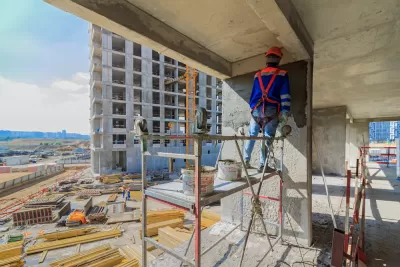Zoning and the economy aren't the only factors in neighborhood change—financial regulations and policies, sometimes seemingly unrelated, also have an effect.

Michael Reher writes to reveal an underappreciated factor in the rental housing affordability crisis in the United States: changing financing practices.
According to the findings of Reher's new working paper, "much of the growth in apartment improvements, the rise in rents, and the loss of low-income units were the result of a change in bank regulations and the interplay between low-interest rates and the rules that govern underfunded public pension funds."
With renovations, for instance, Reher traces the increase in residential improvements with multiple changes that funneled funding for renovations away from other kinds of residential investments.
The first is High Volatility Commercial Real Estate (HVCRE) bank capital requirements introduced in 2015 in accordance with the requirements of the 2010 Dodd-Frank Wall Street Improvement and Consumer Protection Act. These regulations, which were supposed to make the financial system more stable by requiring banks to have greater reserves for riskier loans, categorized loans secured by improvements on rental properties as significantly less risky than loans for the construction of new rental units.
Reher provides this summary of the paper's findings to conclude a more detailed article:
Collectively, my findings indicate that the regulatory changes and the changes made by public pension fund managers together accounted for around one-third of real improvement activity over 2010-2016. During this period, quality improvements accounted for 65 percent of rent growth (though this number includes improvements not necessarily created by the previous two shifts).
FULL STORY: HAVE CHANGES IN FINANCING CONTRIBUTED TO THE LOSS OF LOW-COST RENTAL UNITS AND RENT INCREASES?

Maui's Vacation Rental Debate Turns Ugly
Verbal attacks, misinformation campaigns and fistfights plague a high-stakes debate to convert thousands of vacation rentals into long-term housing.

Planetizen Federal Action Tracker
A weekly monitor of how Trump’s orders and actions are impacting planners and planning in America.

In Urban Planning, AI Prompting Could be the New Design Thinking
Creativity has long been key to great urban design. What if we see AI as our new creative partner?

King County Supportive Housing Program Offers Hope for Unhoused Residents
The county is taking a ‘Housing First’ approach that prioritizes getting people into housing, then offering wraparound supportive services.

Researchers Use AI to Get Clearer Picture of US Housing
Analysts are using artificial intelligence to supercharge their research by allowing them to comb through data faster. Though these AI tools can be error prone, they save time and housing researchers are optimistic about the future.

Making Shared Micromobility More Inclusive
Cities and shared mobility system operators can do more to include people with disabilities in planning and operations, per a new report.
Urban Design for Planners 1: Software Tools
This six-course series explores essential urban design concepts using open source software and equips planners with the tools they need to participate fully in the urban design process.
Planning for Universal Design
Learn the tools for implementing Universal Design in planning regulations.
planning NEXT
Appalachian Highlands Housing Partners
Mpact (founded as Rail~Volution)
City of Camden Redevelopment Agency
City of Astoria
City of Portland
City of Laramie





























